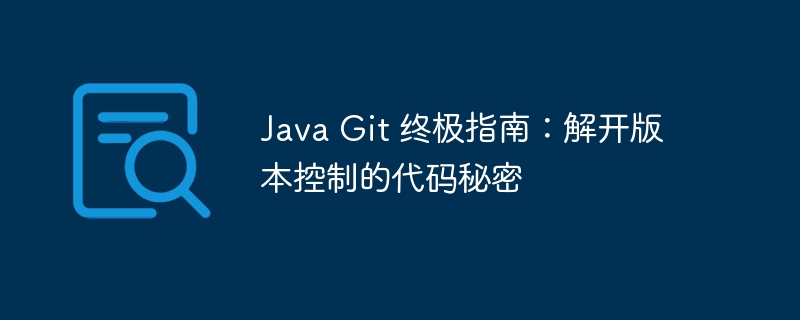

The Ultimate Guide to Java Git: Unlocking the Code Secrets of Version Control Version control is an essential part of software development. Git, as one of the most popular version control tools currently, provides Java developers with powerful code management functions. The Ultimate Guide to Java Git carefully crafted by php editor Yuzai will reveal various advanced techniques and practical functions of Git to help you better master version control, improve team collaboration efficiency, and optimize the code management process. Start exploring now and unlock code secrets!
git is a distributed version control system widely used in Java development. It allows developers to track code changes, collaborate to resolve conflicts, and maintain project history. This article will guide you to understand the basic knowledge of Java Git, help you unlock the power of version control, and improve your code development process.
The basics of GitGit uses repositories (warehouses) to manage code changes. Each repository contains a pointer called HEAD, which points to the currently active branch. Branches are independent versions of code that allow developers to work on multiple features or fixes at the same time.
Installation and ConfigurationTo use Git, you need to install it on your local computer. Please visit the Git official website (https://git-scm.com/) to download and install Git. Once the installation is complete, you can set it up using the following command:
git config --global user.name "Your Name" git config --global user.email "youremail@domain.com"
To add Git to an existing project, navigate to the project directory and run:
git init
This will create a hidden folder named
.git that contains the repository information.
After you make changes to your code, you need to add them to Git using the following steps:
Add changed files:
Commit changes:
Push changes to the remote repository:
Branch is a
tool used in Git to isolate different code changes. To create a branch, use:
git branch <branch_name>
git checkout <branch_name>
To merge changes, you can use:
git merge <branch_name>
When multiple developers edit the same code at the same time, conflicts may occur. To resolve conflicts, manually edit the conflict file, mark the resolved conflicts and commit the changes.
Code reviewGit provides powerful code review capabilities. You can ask others to review changes using
git request-pull, and use git fetch to view changes requested by others.
In addition to the basics, Git also provides some advanced features, such as:
There are many Java tools available to enhance your Git experience, including:
Mastering Java Git is the key to improving the
software developmentprocess and enhancing code collaboration. By understanding its basics, advanced features, and Java tools, you can unlock Git's full potential, unlock the secrets of your code, and enhance your development experience.
The above is the detailed content of The Ultimate Guide to Java Git: Unlocking the Code Secrets of Version Control. For more information, please follow other related articles on the PHP Chinese website!




